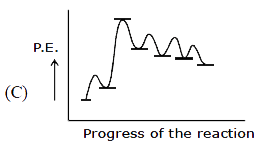Ph−Ph∣C1∣OH−Ph∣C2∣OH−CH3H+−−→?
To solve the given problem, we need to analyze the reaction of a diol with H⁺ and determine the stability of the resulting carbocations formed from two different routes. Here’s a step-by-step breakdown of the solution:
Step 1: Identify the Structure
The compound given is a diol with two hydroxyl (OH) groups attached to two different carbon atoms, each of which is also connected to a phenyl group (C₆H₅). The structure can be represented as:
- C₁: Phenyl - OH
- C₂: Phenyl - CH₃
Step 2: Protonation of Hydroxyl Groups
When H⁺ is added to the diol, it can protonate one of the hydroxyl groups. This protonation makes the hydroxyl group a better leaving group, converting it to water (H₂O).
Step 3: Consider Two Possible Routes
1. Route 1: Protonation occurs at the hydroxyl group on carbon C₁.
2. Route 2: Protonation occurs at the hydroxyl group on carbon C₂.
Step 4: Formation of Carbocations
- Route 1:
- Protonation of the OH on C₁ leads to the formation of a carbocation at C₁. The structure will look like this:
- C₁: Ph - C⁺ (carbocation) - C₂: Ph - CH₃
- Route 2:
- Protonation of the OH on C₂ leads to the formation of a carbocation at C₂. The structure will look like this:
- C₁: Ph - C₂: C⁺ (carbocation) - CH₃
Step 5: Analyze Carbocation Stability
- Route 1: The carbocation at C₁ is stabilized by resonance from the two phenyl groups attached to it. This resonance allows for delocalization of the positive charge, making it more stable.
- Route 2: The carbocation at C₂ is less stable because it is only stabilized by the single phenyl group and the methyl group, which does not provide as much resonance stabilization.
Step 6: Conclusion
Since the carbocation formed at C₁ (Route 1) is more stable due to the resonance provided by the two phenyl groups, the reaction will predominantly proceed through this route.
Final Product
The final product after the loss of water (dehydration) will be a double bond between C₁ and C₂, resulting in a stable alkene with the structure:
- C₁: Ph - C=C - Ph - CH₃
The compound given is a diol with two hydroxyl (OH) groups attached to two different carbon atoms, each of which is also connected to a phenyl group (C₆H₅). The structure can be represented as:
- C₁: Phenyl - OH
- C₂: Phenyl - CH₃
When H⁺ is added to the diol, it can protonate one of the hydroxyl groups. This protonation makes the hydroxyl group a better leaving group, converting it to water (H₂O).
1. Route 1: Protonation occurs at the hydroxyl group on carbon C₁.
2. Route 2: Protonation occurs at the hydroxyl group on carbon C₂.
- Route 1:
- Protonation of the OH on C₁ leads to the formation of a carbocation at C₁. The structure will look like this:
- C₁: Ph - C⁺ (carbocation) - C₂: Ph - CH₃
- Route 2:
- Protonation of the OH on C₂ leads to the formation of a carbocation at C₂. The structure will look like this:
- C₁: Ph - C₂: C⁺ (carbocation) - CH₃
- Route 1: The carbocation at C₁ is stabilized by resonance from the two phenyl groups attached to it. This resonance allows for delocalization of the positive charge, making it more stable.
- Route 2: The carbocation at C₂ is less stable because it is only stabilized by the single phenyl group and the methyl group, which does not provide as much resonance stabilization.
Since the carbocation formed at C₁ (Route 1) is more stable due to the resonance provided by the two phenyl groups, the reaction will predominantly proceed through this route.
The final product after the loss of water (dehydration) will be a double bond between C₁ and C₂, resulting in a stable alkene with the structure:
- C₁: Ph - C=C - Ph - CH₃
Topper's Solved these Questions
- ALCOHOLS, ETHERS AND PHENOLS BOOK - FIITJEECHAPTER - ALCOHOLS, ETHERS AND PHENOLS EXERCISE - PROBLEM SOLUTION (SUBJECTIVE)
16 Videos
- ALCOHOLS, ETHERS AND PHENOLS BOOK - FIITJEECHAPTER - ALCOHOLS, ETHERS AND PHENOLS EXERCISE - PROBLEM SOLUTION (OBJECTIVE)
16 Videos
- ALDEHYDES AND KETONES BOOK - FIITJEECHAPTER - ALDEHYDES AND KETONES EXERCISE - MATCHING LIST QUESTIONS
2 Videos
Similar Questions
Knowledge Check
CH3−OH∣C∣H−CN is
AAcetaldehyde cyanohydrinBAcetone cyanohydrinCCyanoethanolDEthanol nitrilePh−Ph∣C∣H−H∣C∣CH3−CH2−OHH+−−→Δ Product
Select the correct P.E. graph for major product.A B
B C
C DNone
DNonePh−Ph∣C∣OH−CH3∣C∣OH−CH3+Ph−Ph∣C∣OH−Et∣C∣OH−EtH2SO4−−−→
APh−Ph∣C∣Et−O∣∣C−CH3BPh−Ph∣C∣Et−O∣∣C−EtCPh−Ph∣C∣Et−O∣∣C−CH3DPh−Ph∣C∣CH3−O∣∣C−Et
Cl−Cl∣C∣Cl−OH∣C∣H−OH
View SolutionWrite the names of the following compounds.
(a) H−H∣C∣H−H∣C∣H−H∣C∣H−H∣C∣H−O∣∣C−OH , (b) H−H∣C∣H−H∣C∣H−H∣C∣H−C≡C−H
(c ) H−H∣C∣H−H∣C∣H−H∣C∣H−H∣C∣H−H∣C∣H−H∣C∣H−H∣C=O , (d) H−H∣C∣H−H∣C∣H−H∣C∣H−H∣C∣H−H∣C∣H−OH
View SolutionPredict the product of following cross condensation reactions.
(a)CH3−CH3∣C∣CH3−C∣∣O−H+CH3−C∣∣O−HOHΘ/Δ−−−−−→ Ph−C∣∣O−H+CH3−CH2−C∣∣O−HOHΘ/Δ−−−−−→
View SolutionIdentify and name the functional groups present in the following compounds.
(a) H−H∣C∣H−H∣C∣H−H∣C∣H−OH , (b) H−H∣C∣H−H∣C∣H−O∣∣C−OH
(c ) H−H∣C∣H−H∣C∣H−O∣∣C−H∣C∣H−H∣C∣H−H , (d) H−H∣C∣H−H∣C∣H−H∣C=H∣C−H
View SolutionWrite the names of the following compounds :
H−H∣C∣H−H∣C∣H−H∣C∣H−H∣C∣H−O∣∣C−OH
View Solution